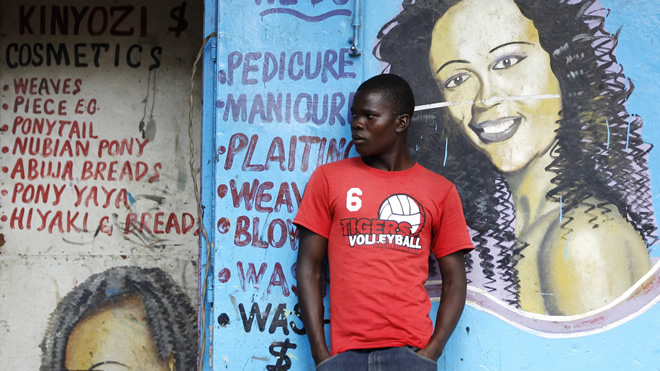
A man stands outside a beauty parlor in the Nairobi neighborhood of Eastleigh, also known as "Little Mogadishu."(Reuters/Thomas Mukoya)

Friday, May 01, 2015
The tragic events that took place at Kenya’s Garissa University on Apr. 2, 2015, , in which 147 students were killed by militants linked with al-Shabaab, kick-started another round of xenophobic initiatives proposed in the country’s legislature.
Under president Uhuru Kenyatta’s leadership, the country has taken steps to close the Dabaab refugee camp near the border with Somalia, and forcibly repatriate its inhabitants. Kenyatta has also authorized an uptick in surveillance of Somali communities in Nairobi, and the construction of a “security wall” along the Kenyan-Somali border.
Human-rights activists and security analysts alike have decried the plans as a mixture of short-sightedness, xenophobia, and infeasibility. Overlooked, however, have been the potential economic consequences of these actions; in persecuting Somalis, Kenya risks undermining its position as a regional economic leader. While Somalis in Kenya may be a convenient scapegoat in the face of an increasingly tangible jihadi threat, the persecution of these populations will not lead to a more secure Kenya, and will likely stunt the country’s economy.
The Dabaab refugee camp houses roughly 500,000 people, making it one of the largest refugee camps in the world. Unofficially, it is the third largest city in Kenya.
Though Dabaab is located in the Garissa district, the perpetrators of the attack on Garissa University were Kenyan, and at least three of the four perpetrators came from other regions in the country.
As far back as 2012, Kenyan politicians have sought to close the Dabaab refugee camp. Then, former president Mwai Kibaki asserted that it was “unsustainable,” and requested international support to return Somali refugees to their home country. Today, president Kenyatta argues that the camp has become a national-security threat, and has stipulated a timeline of three months to resettle Somali inhabitants.
The office of the UN high commissioner for refugees has said that this would have “extreme humanitarian and practical consequences, and would be a violation of Kenya’s international obligations.”
Closing Dabaab would also endanger the economy of the Garissa district. According to a 2010 study commissioned by the Kenyan, Danish, and Norwegian governments, Dabaab has an annual internal economy of roughly $25 million and injects an additional $14 million into the surrounding community. Given that the overall poverty rate in Garissa, according to USAID Kenya, is 49.2%, there is more to be gained from greater economic integration with the camp than the deportation of its residents.
In addition to targeting Somali refugees in Dabaab, Kenya’s government has stepped up surveillance of Somalis in its capital city of Nairobi. In particular, residents of the Eastleigh neighborhood (nicknamed “Little Mogadishu”) have been subject to police harassment, and there are reports of extrajudicial police brutality. Somalis in Eastleigh claim that, since the Garissa attack, the police have conducted raids on apartments, “brandishing AK-47s, banging on doors, demanding to see national identification cards.”
In their wake, they leave trashed homes and take with them bribes and the property of those suspected of Islamist links. The police’s actions echo the events following last year’s Westgate Mall attack and a spate of small scale attacks claimed by al-Shabaab.
According to Amanda Sperber, “hundreds [of Somalis] were reportedly held in putrid conditions in local police stations, and more than a thousand were held in Kasarani sports stadium; journalists and humanitarian organizations were banned from entering, eventually sparking an international outcry.”
In persecuting the residents of Eastleigh, Kenya may be killing the goose that laid the golden egg. According Nahashon N. Nyagah in the Kenyan National Assembly Official Record of 2000, “47% of Kenya’s GDP is derived from Nairobi,” and his constituency contributes the second-greatest amount toward that figure “partly because of that area called Eastleigh.”
The malls in Eastleigh alone contribute more than $7 million a year to the economy. In October 2014, Kenya rebased its economy and joined the ranks of middle-income countries, and is now one of Africa’s ten largest economies.
The Kenyan economy has been driven by the innovations and sectors associated with urbanization. Somali migrants and refugees have played a critical role in this growth; their detainment, harassment, and repatriation (voluntarily or forcibly) will leave entire neighborhoods vacant and stunt economic productivity.
The proposed security wall, too, will undermine regional trade. Mandera, a county in Kenya’s northeastern border with Somalia, has already received construction equipment to build the proposed blockade. While Kenyan authorities assert that the wall will stem the flow of potential terrorists crossing into Kenya, it is more likely that the wall will divert trade lifeline.
Merchants and herders in the area rely upon a permeable border for their livelihoods. Dawud Farah, a camel breeder in Mandera, told The New York Times that the blockade would prevent him from having adequate grazing land for his camels. A local businessman also reported that the wall would lead to a spike in local food prices. He explained that a bag of rice from Somalia cost roughly $15, “the same bag of rice from the Kenyan capital… would cost $50.”
Though Kenyan officials seek to promote security in their country, the proposed policies regarding Somalis in Kenya are more likely to lead to human rights violations and increasing poverty than to stability. In redressing the wounds inflicted by al-Shabaab, Kenyan officials are shooting themselves in the foot.